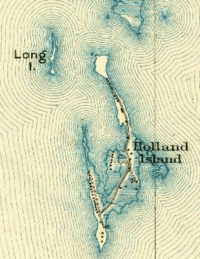Long Island (Maryland) facts for kids

Map of Long Island and Holland Island from a 1927 Topographic Map
|
|
| Geography | |
|---|---|
| Location | Chesapeake Bay |
| Coordinates | 38°08'11.8"N 76°05'57.6"W |
| Administration | |
|
United States
|
|
| State | Maryland |
| Demographics | |
| Population | 0 |
Long Island was once a small island located in the Chesapeake Bay, a large body of water in Maryland, United States. It was situated northwest of another island that also disappeared, called Holland Island.
Long Island was visible on maps until about 1934. Around that time, a combination of natural forces caused it to vanish beneath the waves.
Contents
What Happened to Long Island?
Long Island disappeared due to two main reasons: erosion and sea level rise. These natural processes slowly changed the landscape of the Chesapeake Bay.
Erosion: The Bay Eating Away at Land
Erosion is when natural forces like wind and water wear away at land. For islands in the Chesapeake Bay, the main culprit is water. Waves constantly crash against the shore, carrying away sand and soil. Over many years, this can make an island smaller and smaller until it's gone.
- Waves: Strong waves, especially during storms, can quickly wash away parts of an island.
- Currents: Water currents in the bay also move sediment, slowly eroding the land.
- Soft Soil: Many islands in the Chesapeake Bay are made of soft soil and sand, which are easily washed away.
Sea Level Rise: The Water Gets Higher
Sea level rise means that the average level of the ocean's surface is slowly getting higher. This is happening all over the world. When sea levels rise, low-lying areas, like small islands, can become submerged.
- Melting Ice: One reason for rising sea levels is the melting of glaciers and ice sheets.
- Warming Water: As ocean water gets warmer, it expands, taking up more space.
- Sinking Land: In some areas, the land itself is slowly sinking, which makes the sea level appear to rise even faster.
How Sea Level Rise Affects Islands
Imagine a small sandcastle on the beach. If the tide slowly comes in, the sandcastle will eventually be covered by water. This is similar to what happened to Long Island. As the sea level in the Chesapeake Bay slowly rose, the island became more vulnerable to waves and eventually disappeared.
The Fate of Other Chesapeake Bay Islands
Long Island is not the only island in the Chesapeake Bay that has disappeared. Many small islands in the bay have been lost to erosion and rising sea levels over the past century.
Holland Island: A Neighbor Lost
Holland Island was a larger island located near Long Island. It was once home to a thriving fishing community with houses, a school, and a church. However, like Long Island, it faced severe erosion and rising water levels. The last house on Holland Island collapsed into the bay in 2010. Its disappearance is a powerful example of how natural forces can change our world.
Why Are These Islands Important?
Even though Long Island is gone, understanding its disappearance helps us learn about our environment. It shows us how powerful natural processes like erosion and sea level rise can be. Studying these former islands helps scientists understand how to protect coastal areas and other islands that are still here today.

